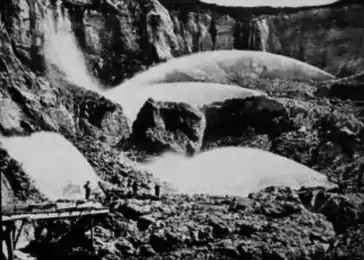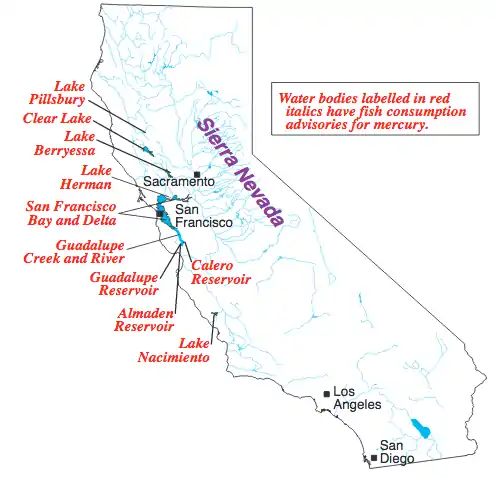Mercury contamination in California waterways
Mercury contamination in California waterways posed a threat to both the environment and human health. The roots of the problem are in gold mining; since the California Gold Rush, mercury has been used for gold extraction. Historically, 10-30% of mercury was lost in the mining process, resulting in widespread contamination of river and lake sediments. Many water bodies in the state of California bear fish consumption advisories due to mercury content.
History of California mining

The California Gold Rush can be traced to James Marshall's January 24, 1848 discovery of gold on John Sutter's property.[1] Marshall was building a saw mill right next to the river for Sutter, and the night before the iconic gold discovery Marshall diverted water from the American River through the lumber mill he was constructing tailrace to wash away loose gravel and dirt. The next morning (January 24, 1848) he discovered metallic flecks where the river water was flowing through the saw mill. He thought it was gold immediately, but didn't pursue it until the Sutter sawmill was completed.[1]
By the time of the following spring Marshall's gold discovery, the largest gold rush in American history began. In this short year the non-Native American population raised from 14,000 to 100,000.[1] The population increased again to 250,000 by the year of 1892.[1]
Gold was easily extracted from the rivers, by scooping and silling the river soil and gravel. The bottom trawler method was also developed to extract more gold at once. This was the pulling of metal baskets and rakes across the river beds to stir up gold, and scoop out gravel that was rich in gold. It was later, when the gold in the river bed wasn't as plentiful, that new mining techniques were being developed to extract gold more efficiently from the ground.[2] One of the main, and also most destructive methods was that of hydraulic mining. This involved the redirecting of water from the river into a narrow channel, into a large canvas hose, and iron nozzle. Then these water canons which were called monitors it would shoot a very high pressure stream that would break apart hillsides. The water, slurry, and debris, mostly gravel would flow over large sluices and drainage tunnels.[3] This was also when mercury was beginning to be used to help extract the gold from the masses of ore and silt.[2]
Use of mercury in gold mining
Historically mercury, otherwise called "quicksilver" was used during the mining process.[2] During hydraulic mining when the water, slurry, and debris flowed over the sluices and drainage tunnels, the particles were also mixed with liquid mercury.[3] The mercury was used during the extraction period during the mining process. The mercury was used to attract the gold and sometimes silver from the mining ore, for extraction.[4] The most common use of mercury for the extraction was a process called mercury amalgamation.
The way that this process works is that the miner mixes the element mercury with mining silt or ore, the mercury then sticks to the gold, thus separating from the ore and silt, forming one solid piece of mercury–gold amalgam.[5] Additional separation from the silt and ore is done by washing away the ore with water until only the amalgam is left. The next step of the process is to separate the actual gold form the now useless mercury. The way this is done, is the miners heat up the mercury-gold amalgam to high temperature to vaporize the mercury away, leaving only the highly desired gold.[5] The vaporization of mercury requires a temperature of at least 357 °C.[6] In addition to the mercury-gold amalgam some residue mercury is also still present in the silt and ore that was washed away, sometimes referred to as mine tailings. When these mine tailings are disposed of and during the washing process, large amounts of the remaining mercury often pollutes and infiltrates the local ecosystems and especially waterways around and down steam from the mining sites.[3][5] There was a loss of 10-30% of the mercury used during the extraction process, per season, which resulted in highly contaminated sediments at and down stream form mining sites.[3] The highest mercury contamination levels are present and can be sourced back to the Placer area in California.[3]
Environmental impacts

When mercury first enters into waterways and ecosystems, it is considered elemental inorganic mercury. It is not until being in the ecosystems that the elemental inorganic mercury is then converted into methylmercury by the inhabitant organisms and various forms of bacteria.[7] These bacteria are known as anaerobic bacteria species, which convert elemental mercury into methylmercury when the bacteria methylate oxidized mercury into methylmercury.[7]
The environments that methylmercury levels are most commonly found at high levels, or future high risks are wetlands, newly flooded reservoirs, aquatic areas close to mining sites or factories, bays, and waterways with low pH levels. These factors when presented with high mercury levels, are home to the bacteria that process it.[8] These methylmercury containing bacteria are what are then eaten by the next higher level in the food chain. Some methylmercury containing bacteria also excrete the toxin directly into the water.[8]
This newly transformed form of mercury (methylmercury) then begins to bio-accumulate in the many species inhabiting the contaminated waterways and ecosystems.[5] Animals accumulate methylmercury in their body's faster, then it leaves their systems, resulting in each successive species in the food chain consuming higher levels of methylmercury. The bio-accumulation levels of toxic methylmercury are highest by larger predator fish species, fish eating animals, and humans which fish being a prominent food source for humans, causes much additional worry.[8] Though methylmercury traces have also been found in reptiles, amphibians, invertebrates, flora, birds, and even the surrounding soil.[3]
The many health effects of methylmercury has on wildlife include reproductive problems and reductions, enzyme and immune system problems, developmental issues, and genetic alterations.[8] These problems have had the greatest effects on waterfowl because of their high fish diets. Some of the waterfowl experiencing the most problems with methylmercury are the Great Egret, Diving Duck, Herons, and Loons. Research and scientific surveys have shown a dramatic reduction in Loon chicks and a change in juvenile Great Egrets with a direct correlation with high levels of methylmercury.[8] Ecosystems with both methylmercury and the element selenium can produce an even more toxic and potentially deadly mixture for wildlife.[8]
Human health impacts

There have been many studies and negative health impacts, directly relating to mercury contamination in both food sources and the environment. One of the main sources of mercury contamination and over consumption is through fish, already contaminated with high levels of mercury. Mercury can impair, damage, and even destroy functioning nerve tissue-much like lead.[10] The over consumption of methylmercury can also reduce immune system response, damage the nervous system, including coordination, sense of touch, taste, and sight.[8]
One of the major health threats presented from the over consumption of these high mercury levels is the development of learning disabilities and developmental problems in children. This is the result of over mercury exposure after birth, and/or over consumption of high mercury levels of the mother during pregnancy. The high concern is because mercury can be passed between the pregnant mother through the placenta to the unborn fetus.[10] The form that mercury that is being consumed is Methylmercury, which the federal government has classified as a neurotoxin, which is described as a poisonous substance that attacks the nervous system, and impairs the function of the nerve and nerve tissue.[11] Even small amounts of this neurotoxin can cause brain and nervous system development problems. The effects of this utero (before birth in the uterus)[11] transfer can also take between a number of months or even years before signs appear, making it difficult to trace back. The forms that methylmercury exposure will show itself is that the child will have shorter attention spans, poor fine motor skills, slow language development, visual-spatial abilities (like drawing), and memory.[10] A mothers exposure and consumption of methylmercury prior to pregnancy can also be just as serious as exposure during pregnancy, because methylmercury is slowly excreted from the body, sometimes taking months to fully leave an individuals system. This can greatly effect the fetuses development, as many important developmental stages of the nervous systems and brain occur during the first two months of pregnancy. Health experts suspect that children are more susceptible to methylmercury than adults, because they eat more food relative to their total body weight causing a higher contamination percentage.[10] It has been concluded that 60,000 children born each year are at risk for neuro-developmental effects, due to in utero exposure to methylmercury.[8]
Another form of human exposure to elemental mercury is the inhalation of the vaporized form of the element directly from its source in the environment. This form of exposure is especially common in and around old mining sites.[8] This form of exposure can cause gingivitis, tremors, damages to the gastrointestinal tract, less efficient enzyme productivity, and in rare cases kidney failure.[8]
Removal from water
There have been many studies on the purification and extraction of mercury from water sources and sometimes even the affected soils around the contaminated water sources. Some of these methods that are continuously being researched and sampled are the use of high-performance liquid chromatography (HPLC) combined with inductively-coupled plasma mass spectrometry (ICP-MS).[12] Because the different forms of mercury have different forms of toxicity, this method allows for the removal of each form and a thorough study of the toxicity and potential harm of each separate form. This is because the typical concentration of methylmercury in water sources and ethylmercury is below detection rates, but it doesn't necessarily mean the continuous buildup in the consumers body's, or the environment will have any symptoms. The most common method of speciation for the removal, is gas chromatography or high-pressure liquid chromatography paired with fluorescence, natural elements, and photometry detectors.[12] The downside of this form of detection is that it requires very large numbers of samples to test the concentration and toxicity levels. Other methods include the charging of ions to separate the toxic elements and toxins from the water for extraction. These methods are currently most common for use in China, for the removal of these toxic heavy metals for the use of drinking water.[12] One theory that is being tested by the federal government to clean methylmercury out of waterways, is to find a bacterium that transforms methylmercury back into elemental mercury. With this process of transformation, the elemental mercury can vaporize and evaporate out of the waterways naturally.[7]
See also
Works cited
- "Gold Rush Overview". www.parks.ca.gov. Retrieved 2016-05-09.
- "Hydraulic Mining, Mining Techniques, Underground Mining, Copper Mining, Lead Mining". www.greatmining.com. Retrieved 2016-05-09.
- Alpers, Charles; Hunerlach, Michael (May 2000). "Mercury Contamination from Historic Gold Mining in California" (PDF). USGS: Science for a Changing World. Retrieved May 13, 2016.
- "Gold Processing: Mercury Usage in Gold Mining – MiningFacts.org". www.miningfacts.org. Retrieved 2016-04-21.
- ":: WorstPolluted.org : Projects Reports". www.worstpolluted.org. Retrieved 2016-05-09.
- "Mercury in the Laboratory". www.ilpi.com. Retrieved 2016-05-09.
- "Multiple Species of Bacteria Convert Elemental Mercury to Toxic Methylmercury | U.S. DOE Office of Science (SC)". science.energy.gov. Retrieved 2016-05-09.
- "Mercury in the Environment". www2.usgs.gov. Retrieved 2016-05-15.
- Alpers, Charles; Hunerlacy, Michael (May 2000). "Mercury Contamination from Historic Gold Mining in California" (PDF). USGS: Science for a Changing World. Retrieved 12 May 2016.
- Silver, Larry. "Mercury and Learning disabilities: A Parents Guide" (PDF). Natural Resources Defense Council. Retrieved August 5, 2011.
- "Dictionary and Thesaurus | Merriam-Webster". www.merriam-webster.com. Retrieved 2016-05-09.
- Chen, Dengyun; Jing, Miao; Wang, Xiaoru (September 6, 2014). "Determination of Methyl Mercury in Water and Soil by HPLC-ICP-MS" (PDF). Agilent Technologies. Agilent Technologies Inc. Retrieved May 5, 2016.